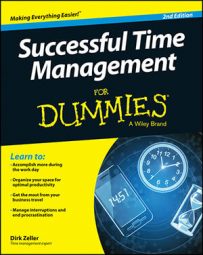One critical key to success in helping an employee manage time is to involve the individual, so be sure one of the first steps you take is to confirm employee buy‐in. You want to put together a plan in which the employee has as much ownership as you do, and that means involving him or her at the outset.
You can’t afford not to pass along time-management tips to your employees. If you’re like most managers, you may find that training your employees in time management helps you improve your own time-management skills further. Teaching others is the best way to reinforce your knowledge and discover even more about a topic.
Don’t neglect the costs of employees who work excessively. Some people feel that how many hours they work in a week is a badge of honor. This warped thought process leads to excessive time at the job, which can lead to burnout, lower production, and lower levels of job satisfaction. If the employee isn’t salaried, then overtime costs are significant to companies as well.
Discerning whether your employee is ready to change
Most people don’t change their time-management (or any other) strategy unless they’re experiencing some type of pain: They’ve had enough, heard enough, or hurt enough:
Had enough: They’re frustrated and feel like they’re always at work. They’ve missed enough dinners with family, T‐ball games, swimming lessons, kindergarten graduations, and nights out to say, “I’m going to make a change.” This one is the best of the three options because it’s created internally, so it has greater odds of sticking. The employee may come to you for guidance.
Heard enough: When a staffer reaches the “had enough” level but still presses on, ignoring repeated warnings in various forms, it may be time for the manager (that’s you) to step in and have some serious discussions with him or her.
Nagging isn't a strategy to improve an employee’s time management, but repetition and consistency of message have their place.
Hurt enough: As a manager, friend, and colleague, “hurt enough” is the learning experience you want employees to avoid. An employee comes home one day and the kids and spouse are gone because he or she was never home. Or employee health issues border on catastrophic because he or she never “had time” to attend to his or her physical well‐being.
Spend some time talking to the employee and you’re bound to discover whether he or she has reached — or is close to — one of these crossroads. Then you want to try to connect with the person on an emotional level.
Helping your employee want to change
Most human beings make decisions — even big decisions — largely based on emotions. Then they justify those decisions with logic, data, or facts. Achieving buy‐in from employees isn’t solely about goals, benefits, and time management skills. It’s also about employees’ emotions.
Tapping into your employees’ feelings can help you persuade them to try your new time-management strategies. Try these questions to explore their emotions regarding time management:
“How do you feel when you miss your quota for the month?”
“How do you feel when you’re interrupted regularly by others?”
“What are your feelings when I delegate a few projects in a row?”
Next, use follow‐up questions to move from emotions to action:
“How can I help you reduce those feelings? How can you reduce them?”
“What can I do to help you feel more positive and energized rather than drained and frustrated? What can you do?”
The answers — or emotions — your questions elicit help prompt your employee to buy into a plan for improved time management. Tell your employees that based on their responses, you’d like to work with them to develop a time-management plan with concrete steps they can take to improve their skills.

